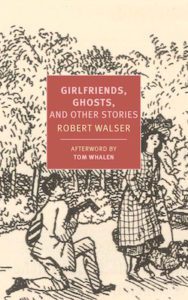
As Tom Whalen says in the epilogue to Girlfriends, Ghosts, and Other Stories, anything can be a source of inspiration for the feuilletonist, but only “the rare feuilletonist […] can bestow permanence to reality’s ephemera”. This was the case of Robert Walser. He had the ability to present common things and day-to-day life in a new light and reveal an unknown side of them.
Girlfriends, Ghosts and Other Stories, translated by Whalen along with Nicole Köngeter and Annette Wiesner, is a collection of brief tales written by Robert Walser between 1904 and 1933. The subject matter is completely different in each story—they are eighty-eight surprises. Every theme is surrounded by an aura of normality: an old fountain, a kitten, a carousel, a landscape, an hour of the day. Walser observes the prosaic items of everyday life and paints what he has experienced through the lens of his imagination, transforming them into literature, as in the following extract from “Autumn Afternoon”:
Looking and hearing joined to make one pleasure, the entire wide green and golden landscape resounded—the bells, the fir forest, the animals, and the people. It was like a painting conjured up by one of the masters. The beech forest was brown and yellow; the green and the yellow and the red and the blue made music. Colors flowed into sound, and sound played with the divinely beautiful colors like boyfriends with sweet girlfriends, like gods with goddesses.
According to Walser, “we don’t need to see anything out of the ordinary” as there is plenty that can be captured through our senses, so much so that he admits to being overwhelmed by the quantity of things that are still out there to be experienced: “I didn’t have eyes enough to look at all there was to see, nor ears enough to hear it all”. Such sensibility allowed him, as W. G. Sebald noted, to register “with seismographic precision […] the slightest tremors at the edges of his consciousness” and, as a result, create stories in which even the smallest detail is treated as if it was a tesella that needs to be put in a specific place to complete the whole image. His language embraces the totality of what he writes about, in words of Rudolf Alexander Schröder, “as though he used his words to grab and keep the essence of everything”.
“A frenetic dance”, “a swallow flight”—these are some of the things that Walser’s prose has been compared to. His literary gymnastics are sometimes difficult to follow. As Tom Whalen points out, “Walser intuited what neurologists later discovered—that movement not stasis is the essence of self”. He writes uninterruptedly, arranging and commenting, declining to puts each fragment of the writing in the correct order. Walser creates his own characteristic literary style.
In “A Little Ramble”, an essential element of Walser’s writing stands out: the walk. For the Swiss author, walking was not only, in his own words, “a continuous working of the legs”, but also an activity that, firstly, imbued him with the necessary material to write and, secondly and more importantly, gave shape to his language. Its beat seems to follow his steps, synchronized, as though the walk builds the writing. He and his language are always in motion together:
The walk on the wonderful road gave me more and more pleasure; first it went up, then straight down again. The whole mountainous world appeared to me like an enormous theater. The road snuggled up splendidly to the mountainsides. Then I came down into a deep ravine, a river roared at my feet, a train rushed past me with magnificent white smoke. The road went through the ravine like a smooth white stream, and as I walked on, to me it was as if the narrow valley were bending and winding around itself.
In some of these brief literary journeys, Walser, aware of his role as a writer and creator, speaks directly to the reader. In “Poet Story”, he writes: “The woman, whom I take the liberty to present to the reader here, had a small, delicate mouth only barely adorned with lips and curls of unusual tenderness”. In moments like this, Walser seems to greet those on the other side, those who will hold his creation in their hands. He frequently remarks about himself and the text. The reader can hear his narrative voice trying to go beyond formality by mentioning the article or essay itself:
I’ve strayed far by digressing from the tram to such sublimity, but I find it quite natural, now I’m at my destination and jump down, and with that this essay is finished; this isn’t the first one, and probably not the last either.
In one of his letters to Christian Morgensten, a German author, Walser asserts that “it is so beautiful to be nothing, it is much more exciting than being something,” and for this reason he feels an insatiable need to write. But in these tales we find a different Walser. The strength that motivated him to write was his willingness to express himself and to leave a mark of his creativity.




